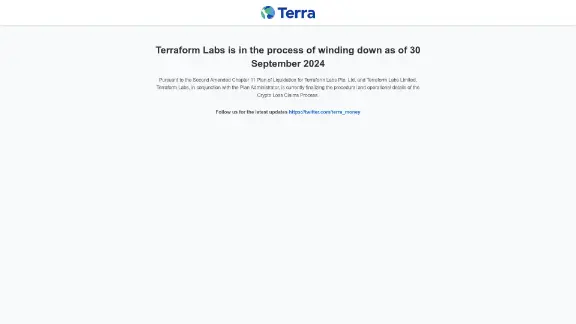Terra (LUNA)
Terra is a blockchain protocol and payment platform that facilitates the use of algorithmic stablecoins. It was developed by Terraform Labs, a startup founded by Do Kwon and Daniel Shin in 2018. The Terra ecosystem is best known for its stablecoin, TerraUSD (UST), and its reserve asset cryptocurrency, Luna.
Overview of Terra
Terra operates using fiat-pegged stablecoins and employs a proof-of-stake consensus mechanism. The platform supports various decentralized applications (DApps) such as Anchor, Mirror, and Pylon. TerraUSD (UST) was a prominent stablecoin on the platform, designed to maintain its peg using a "burn and mint equilibrium" model, which involved a two-token system with Luna absorbing volatility.

| Ticker | LUNA |
| Category | Alleged SEC Securities |
| Website | https://www.terra.money/ |
| @terra_money | |
| Telegram | terranetworklobby |
| https://www.reddit.com/r/terraluna/ |
Anchor and Mirror Protocols
Anchor Protocol was a lending and borrowing platform on Terra, offering yields from Terra's reserves. Mirror Protocol, also on Terra, provided financial derivatives that mirrored real-world stocks.
History of Terra
Terraform Labs, founded in 2018 in Seoul by Do Kwon and Daniel Shin, launched its first token, Luna, in 2019. The company raised over $200 million from notable investors. In January 2022, the Luna Foundation Guard (LFG) was formed to maintain UST's stability.
Key Developments
In February 2022, Terra announced a partnership with the Washington Nationals, rebranding a club as the "Terra Club." Ownership changes occurred within Terraform Labs, with Kwon and Shin initially holding equal shares.
Terra Luna collapse
On May 7, 2022, TerraUSD (UST) experienced a significant drop, leading to the depegging of the stablecoin and a drastic increase in Luna's supply, impacting its value and leading to its delisting from exchanges.
Aftermath of the Luna crash
Following the crash, exchanges like Binance and Coinbase suspended trading of Luna and UST pairings. Terra launched a new blockchain, Terra 2.0, and rebranded the original Luna as Terra Classic (LUNC).
Terra 2.0
Terra 2.0, launched on May 28, 2022, introduced a new blockchain and LUNA cryptocurrency. The original version was rebranded as Terra Classic (LUNC) and airdropped to previous holders.
Airdrop distribution
The airdrop aimed to compensate holders of the original coin. Distribution was based on token holdings and included allocations for pre-attack and post-attack holders, with specified vesting periods.
Tokenomics and LUNA utility
LUNA's protocol uses a burn-and-mint mechanism to maintain its supply. It was initially sold in 2018, with allocations for various stakeholders. LUNA is used for mining transactions, providing incentives to validators, and stabilizing Terra stablecoins.
Terra technology
Terra uses a Proof-of-Stake blockchain requiring miners to stake Luna tokens. This system determines a validator's likelihood to generate the next Terra block.
Terra seigniorage
Seigniorage represents the profit from issuing stablecoins, which Terra uses to fund ecosystem projects and reward users.
Terra governance
Governance in Terra allows participants to vote on proposals, facilitating changes within the network. Proposals require community support and an initial deposit.
Station
Launched on January 14, 2023, Station is an interchain wallet that simplifies interactions with multiple blockchain networks, allowing users to stake, vote, and engage with DApps seamlessly.
Interchain governance
Station's Governance hub offers a centralized platform for voting on proposals across supported chains, allowing users to efficiently participate in governance activities without switching interfaces.
